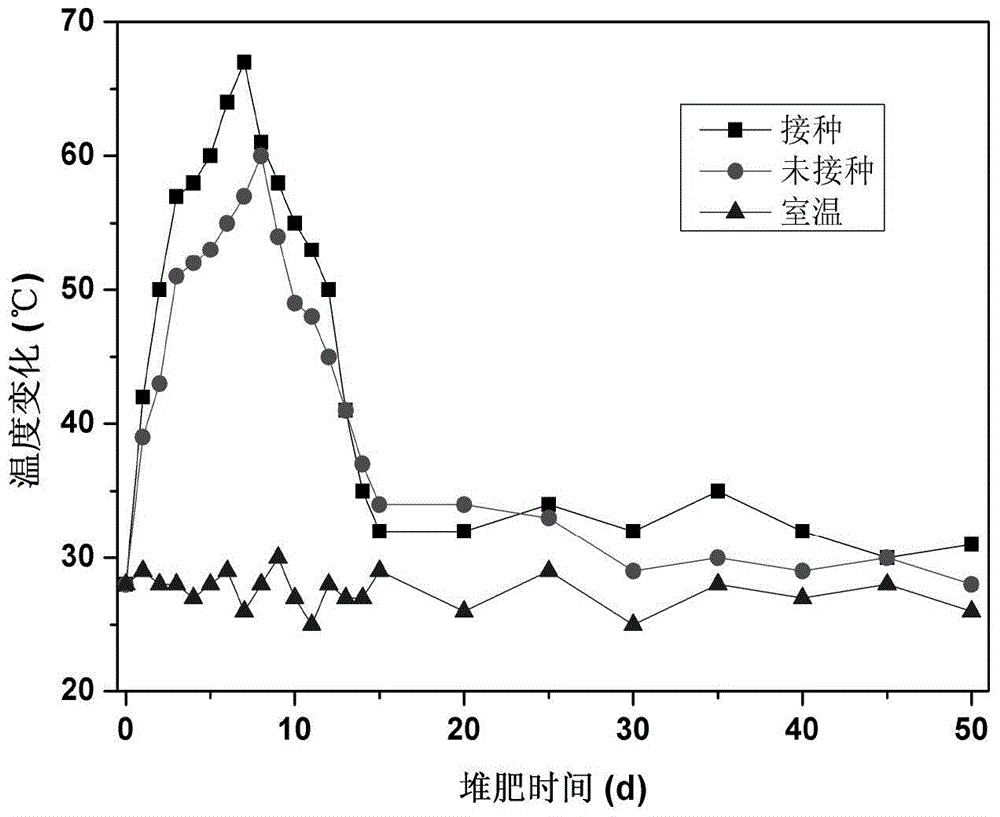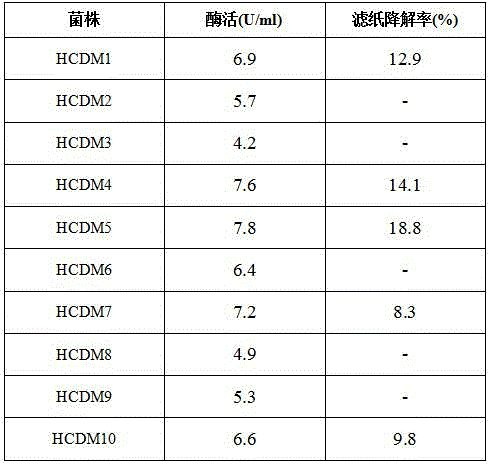High-temperature cellulose degradation bacterium and application thereof
A cellulose-degrading bacteria and cellulose-degrading technology, applied in the field of environmental microorganisms, can solve problems such as decreased thermal stability, and achieve the effects of low cost, fast growth and good performance
- Summary
- Abstract
- Description
- Claims
- Application Information
AI Technical Summary
Problems solved by technology
Method used
Image
Examples
Embodiment 1
[0021] Example 1: Screening and identification of high temperature resistant cellulose degrading bacteria
[0022] Weigh 10 g of garden waste compost samples in the high-temperature period, place them in a conical flask filled with 10 glass beads and 90 ml of sterile water, and shake them on a shaker at 200 rpm for 30 min to fully disperse the samples. At ℃, static enrichment culture was carried out for 12 hours. Use a sterile pipette to draw 1 ml of the supernatant and transfer it to the Hutchinson culture medium, and culture at 70°C for about 30 days. Take 10 ml of the acclimatization solution and transfer it to a new Hutchinson culture solution, and continue the acclimatization culture, so that it can be passaged for 3 times.
[0023] The ingredients of the Hutchinson medium above are: Potassium dihydrogen phosphate 1.0g, Sodium chloride 0.1g, Sodium nitrate 2.5g, Magnesium sulfate 0.3g, Ferric chloride 0.01g, Calcium chloride 0.1g, Starch-free filter paper 10g, 1000ml ...
Embodiment 2
[0040] Embodiment 2: the preparation of solid bacterial agent
[0041] (1) slant activation: take the slant of the microorganisms of the present invention stored at 4°C and inoculate them into LB solid slant medium, and culture them in a thermostat at 70°C for 18 hours to realize the activation of the slant.
[0042] (2) Preparation of seed solution: Inoculate one slant of the strain activated by the slant in step (1) into 1 L of sterile LB liquid culture medium, and culture it on a water bath shaker with a culture temperature of 70°C and an oscillation frequency of 100 rpm, the seed solution was obtained after culturing for 30 h.
[0043] (3) Preparation of fermented seed liquid: the above seed liquid was inoculated into a sterilized fermenter at an inoculum amount of 10% (v / v) for expanded fermentation culture. Under the conditions of temperature 70°C and shaking frequency 120 rpm, fermented seed liquid was obtained after culturing for 48 hours.
[0044] (4) Preparation ...
Embodiment 3
[0045] Embodiment 3: Effect test applied to high temperature composting
[0046] Use garden waste as the main composting material, supplemented with fresh chicken manure, so that the carbon-nitrogen ratio of the mixed material is 25-35:1, and the moisture content is 55-60%. When the maximum temperature of the compost rises to 55°C, the solid bacterial agent prepared in Example 2 is inoculated into the compost material according to the proportion of 15% of the total material, and the carbon-nitrogen ratio is adjusted to 35:1, and the moisture content is 55%. 50d of compost. Simultaneously, the test was carried out without adding the microbial inoculant of the present invention as a control.
[0047] Heap temperature detection: measure once a day for the first 15 days, and measure once every 5 days after that. Turn the pile once every 5 days, turn the pile when the pile temperature reaches 70°C, and keep the pile body temperature between 50-70°C during the high temperature s...
PUM
| Property | Measurement | Unit |
|---|---|---|
| Diameter | aaaaa | aaaaa |
| Length | aaaaa | aaaaa |
| Degradation rate | aaaaa | aaaaa |
Abstract
Description
Claims
Application Information
 Login to View More
Login to View More - R&D
- Intellectual Property
- Life Sciences
- Materials
- Tech Scout
- Unparalleled Data Quality
- Higher Quality Content
- 60% Fewer Hallucinations
Browse by: Latest US Patents, China's latest patents, Technical Efficacy Thesaurus, Application Domain, Technology Topic, Popular Technical Reports.
© 2025 PatSnap. All rights reserved.Legal|Privacy policy|Modern Slavery Act Transparency Statement|Sitemap|About US| Contact US: help@patsnap.com



